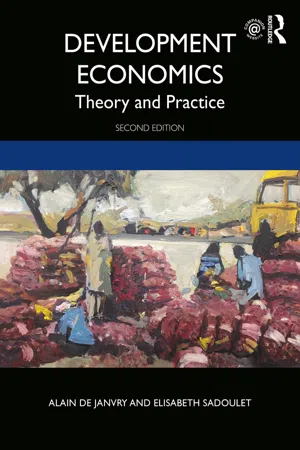
- 548 pages
- English
- ePUB (mobile friendly)
- Available on iOS & Android
About this book
This second edition of Development Economics: Theory and Practice continues to provide students and practitioners with the perspectives and tools they need to think analytically and critically about the current major economic development issues in the world.
Alain de Janvry and Elisabeth Sadoulet identify seven key dimensions of development—growth, poverty, vulnerability, inequality, basic needs, sustainability, and quality of life—and use them to structure the contents of the text. The book gives a historical perspective on the evolution of thought in development. It uses theory and empirical analysis to present readers with a full picture of how development works, how its successes and failures can be assessed, and how alternatives can be introduced. The authors demonstrate how diagnostics, design of programs and policies, and impact evaluation can be used to seek new solutions to the suffering and violence caused by development failures.
In the second edition, more attention has been given to ongoing developments, such as:
- pursuit of the Sustainable Development Goals
-
- continuously rising global and national inequality
-
- health as a domestic and international public good
-
- cash transfers for social protection
-
- carbon trading for sustainability
This text is fully engaged with the most cutting-edge research in the field and equips readers with analytical tools for impact evaluation of development programs and policies, illustrated with numerous examples. It is underpinned throughout by a wealth of student-friendly features, including case studies, quantitative problem sets, end-of-chapter questions, and extensive references. The companion website contains Excel and Stata exercises for students alongside materials for instructors.
This unique text is ideal for those taking courses in development economics, economic growth, and development policy, and will provide an excellent foundation for those wishing to pursue careers in development.
Frequently asked questions
- Essential is ideal for learners and professionals who enjoy exploring a wide range of subjects. Access the Essential Library with 800,000+ trusted titles and best-sellers across business, personal growth, and the humanities. Includes unlimited reading time and Standard Read Aloud voice.
- Complete: Perfect for advanced learners and researchers needing full, unrestricted access. Unlock 1.4M+ books across hundreds of subjects, including academic and specialized titles. The Complete Plan also includes advanced features like Premium Read Aloud and Research Assistant.
Please note we cannot support devices running on iOS 13 and Android 7 or earlier. Learn more about using the app.
Information
Chapter One
What Is Development? Indicators and Issues
Seven Dimensions of Development
Table of contents
- Cover
- Half Title
- Title Page
- Copyright Page
- Table of Contents
- List of Figures and Tables
- Preface
- Acknowledgments
- Introduction
- Chapter One What Is Development?: Indicators and Issues
- Chapter Two The State of Development
- Chapter Three History of Thought in Development Economics
- Chapter Four Impact Evaluation of Development Policies and Programs
- Chapter Five Poverty and Vulnerability Analysis
- Chapter Six Inequality and Inequity
- Chapter Seven International Trade and Industrialization Strategies
- Chapter Eight Explaining Economic Growth: : The Macro Level
- Chapter Nine Exchange Rate Policies and Development
- Chapter Ten The Economics of Farm Households
- Chapter Eleven Population and Development
- Chapter Twelve Labor and Migration
- Chapter thirteen Financial Services for the Poor
- Chapter Fourteen Social Programs and Targeting
- Chapter Fifteen Sustainable Development and the Environment
- Chapter Sixteen Common Property Resources and Determinants of Cooperation
- Chapter Seventeen Human Capital:: Education and Health
- Chapter Eighteen Agriculture for Development
- Chapter Nineteen Development Aid and Its Effectiveness
- Chapter Twenty Institutional Innovations and Development
- Chapter Twenty One Political Economy and the Role of the State
- Index